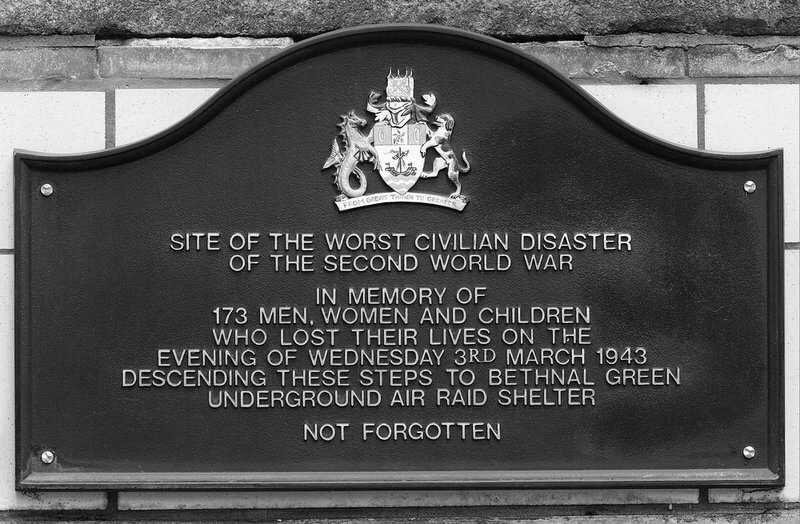On March 3rd 1943, 173 people, including 62 children died in tragic circumstances and over 90 were injured in a crush on a staircase, making this the site of the highest number of civilian casualties in one place in the war.
Although some people think that the disaster at Bethnal Green was caused by a bomb attack, this isn’t the case. It was actually simply a tragic accident. There was an air-raid warning on the night and sirens sounded, telling people to take cover. As with many tube stations in London, the entrance to Bethnal Green is down a flight of stairs. These were blacked-out during air raids so that German bombers could not use their lights as targets. According to witnesses who used the station, the stairs had no handrails on the sides of the staircase, no central dividing rail and only one small blue light to show people where to go.
On March 3rd, the air-raid sirens over London went off at around quarter past eight. Hundreds of local people started to head towards the station and down the staircase to take shelter. Although people were used to the crowds on the stairs and were careful if it was dark, a woman and a child fell over near the bottom of the staircase. The staircase itself is short with only 19 steps, but the crowd was so large and unstoppable that people fell on top of them and then on top of each other.
It is estimated that around 300 people ended up in the crowd on the ground at the bottom of the staircase in less than 20 seconds; over half of them died from crush injuries or asphyxiation. The people at the top and middle of the stairs did not realise what was happening immediately and kept walking down, putting added pressure on the bottleneck trapped below. Sadly, it later turned out that the air-raid warning had simply been a test – there was no bombing raid.

Bethnal Green reports were censored by the government
Far from being an immediate news story, the incident at Bethnal Green tube wasn’t reported for over 24 hours. The actual reports that came out then were censored by the government and did not give a full picture of what had happened; survivors were asked not to talk about the incident at all. This led to speculation of some kind of cover up, although it was more likely done from a moral perspective. From a government perspective, a disaster of this nature would not help the morale of the general public and might put more people at risk if they became worried about using tube stations as shelter.
There may also have been a secret report that claimed that the disaster happened because people panicked and stampeded down the stairs at the sound of anti-aircraft guns. There is no evidence to back this up. There is, however, evidence that the disaster could have been prevented. Apparently, Bethnal Green Council had told the London Civil Defence authority that the stairs on the station needed crush barriers to avoid such an accident as early as 1941. These were installed the day after the disaster.
Bethnal Green Tube Disaster Memorials
The disaster at Bethnal Green was not marked with a memorial until the 1990s. This is a small plaque, but it doesn’t list the names of those who died. Survivors of the disaster and their families return to the station every year on March 3rd to lay flowers by the staircase. The Stairway to Heaven Memorial group has been actively raising funds to build a more fitting commemorative memorial to be unveiled at the station in 2013. This is based around an inverted staircase design, will list all the names and will be used for future anniversary ceremonies.

.jpg)
http://www.eastlondonhistory.co.uk/bethnal-green-tube-disaster-1943/
https://www.ianvisits.co.uk/blog/2013/03/03/70th-anniversary-of-the-bethnal-green-disaster/